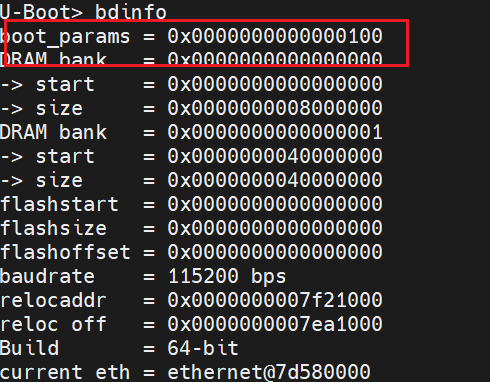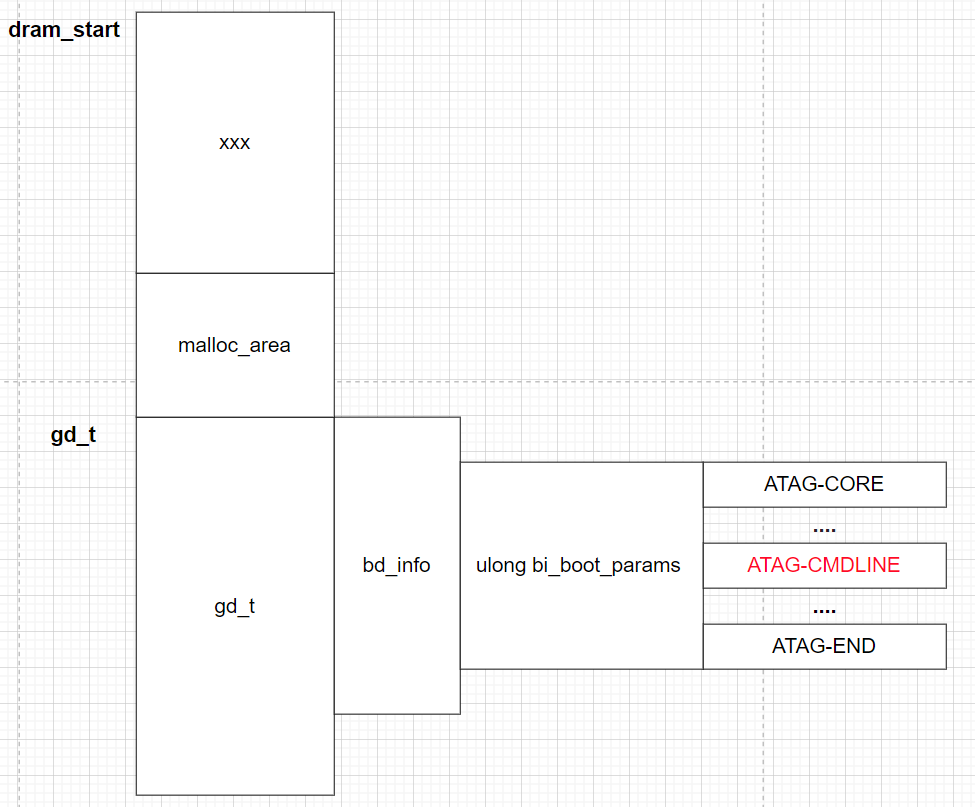简介
uboot在启动内核时,会向内核传递一些参数,可以通过两种方式传递参数给内核,一种是通过参数链表(tagged list)方式,一种是通过设备树方式。文章主要介绍uboot向kernel传参的这两个机制,其中的一个小点,比如 uboot下的bootargs,则是kernel下的cmdline。
启动流程
这里简单列举下启动内核的函数流,以bootm为例
bootm
do_bootm
bootm_run
bootm_run_states
boot_selected_os
boot_fn <=> do_bootm_linux
boot_prep_linux /*准备启动linux之前的一些工作*/
boot_jump_linux /*跳转到linux*/
两种传参机制都在体现在boot_prep_linux函数里面,从代码看出就是三个结果
boot_prep_linux
debug("using: FDT\n");
debug("using: ATAGS\n");
panic("FDT and ATAGS support not compiled in\n");
static void boot_prep_linux(struct bootm_headers *images)
{
char *commandline = env_get("bootargs");
if (CONFIG_IS_ENABLED(OF_LIBFDT) && IS_ENABLED(CONFIG_LMB) && images->ft_len) {
debug("using: FDT\n");
if (image_setup_linux(images)) {
panic("FDT creation failed!");
}
} else if (BOOTM_ENABLE_TAGS) {
debug("using: ATAGS\n");
setup_start_tag(gd->bd);
if (BOOTM_ENABLE_SERIAL_TAG)
setup_serial_tag(¶ms);
if (BOOTM_ENABLE_CMDLINE_TAG)
setup_commandline_tag(gd->bd, commandline);
if (BOOTM_ENABLE_REVISION_TAG)
setup_revision_tag(¶ms);
if (BOOTM_ENABLE_MEMORY_TAGS)
setup_memory_tags(gd->bd);
if (BOOTM_ENABLE_INITRD_TAG) {
/*
* In boot_ramdisk_high(), it may relocate ramdisk to
* a specified location. And set images->initrd_start &
* images->initrd_end to relocated ramdisk's start/end
* addresses. So use them instead of images->rd_start &
* images->rd_end when possible.
*/
if (images->initrd_start && images->initrd_end) {
setup_initrd_tag(gd->bd, images->initrd_start,
images->initrd_end);
} else if (images->rd_start && images->rd_end) {
setup_initrd_tag(gd->bd, images->rd_start,
images->rd_end);
}
}
setup_board_tags(¶ms);
setup_end_tag(gd->bd);
printf("stdebug func:%s line:%d using: ATAGS\n",__func__,__LINE__);
} else {
panic("FDT and ATAGS support not compiled in\n");
}
board_prep_linux(images);
}
atags
现在很多都不用atags的方式传参了,这里介绍一下。uboot把要传递给kernel的参数保存在struct tag数据结构中,启动内核时,把这个结构体的物理地址传递给kernel,kernel会通过这个地址分析出u-boot传递的参数。
首先看一下uboot代码中几个比较重要的数据结构 struct global_data , struct bd_info, struct tag
struct global_data
定义在include/asm-generic/global_data.h这个头文件里面,这里值列举部分成员变量
typedef struct global_data gd_t;
struct global_data {
struct bd_info *bd;
unsigned long flags;
unsigned long env_addr;
phys_addr_t ram_top; //top address of U-boot in RAM
unsigned long relocaddr;
phys_size_t ram_size;
unsigned long irq_sp;
unsigned long start_addr_sp;
unsigned long reloc_off;
struct global_data *new_gd;
const void *fdt_blob;//U-Boot own device tree ,NULL if none
void *new_fdt;
unsigned long fdt_size;
enum fdt_source_t fdt_src;
...
}
uboot在arch/arm/lib/crt0_64.S中指定了gd_t的地址存放在x18寄存器,至于为什么这么做,可以看后面的小节会解释,包括以后分析全流程启动过程也会讲,这里先不深入这个细节。在需要使用gd指针的时候,只需要加入DECLARE_GLOBAL_DATA_PTR这句话就可以使用。
arch/arm/include/asm/global_data.h
#ifdef CONFIG_ARM64
#define DECLARE_GLOBAL_DATA_PTR register volatile gd_t *gd asm ("x18")
#else
#define DECLARE_GLOBAL_DATA_PTR register volatile gd_t *gd asm ("r9")
#endif
#endif
struct bd_info
前面的struct global_data中的第一个成员变量struct bd_info *bd,定义在include/asm-generic/u-boot.h头文件中
struct bd_info {
unsigned long bi_flashstart; /* start of FLASH memory */
unsigned long bi_flashsize; /* size of FLASH memory */
unsigned long bi_flashoffset; /* reserved area for startup monitor */
unsigned long bi_sramstart; /* start of SRAM memory */
unsigned long bi_sramsize; /* size of SRAM memory */
#ifdef CONFIG_ARM
unsigned long bi_arm_freq; /* arm frequency */
unsigned long bi_dsp_freq; /* dsp core frequency */
unsigned long bi_ddr_freq; /* ddr frequency */
#endif
#if defined(CONFIG_MPC8xx) || defined(CONFIG_E500) || defined(CONFIG_MPC86xx)
unsigned long bi_immr_base; /* base of IMMR register */
#endif
#if defined(CONFIG_M68K)
unsigned long bi_mbar_base; /* base of internal registers */
#endif
#if defined(CONFIG_MPC83xx)
unsigned long bi_immrbar;
#endif
unsigned long bi_bootflags; /* boot / reboot flag (Unused) */
unsigned long bi_ip_addr; /* IP Address */
unsigned short bi_ethspeed; /* Ethernet speed in Mbps */
unsigned long bi_intfreq; /* Internal Freq, in MHz */
unsigned long bi_busfreq; /* Bus Freq, in MHz */
#if defined(CONFIG_M68K)
unsigned long bi_pcifreq; /* PCI Bus Freq, in MHz */
#endif
#if defined(CONFIG_EXTRA_CLOCK)
unsigned long bi_inpfreq; /* input Freq in MHz */
unsigned long bi_vcofreq; /* vco Freq in MHz */
unsigned long bi_flbfreq; /* Flexbus Freq in MHz */
#endif
ulong bi_arch_number; /* unique id for this board */
ulong bi_boot_params; /* where this board expects params */
struct { /* RAM configuration */
phys_addr_t start;
phys_size_t size;
} bi_dram[CONFIG_NR_DRAM_BANKS];
};
其中的ulong bi_boot_params表示传递给内核的参数的位置,uboot中命令bdinfo也是查看该结构体的值
那bi_boot_params是怎么初始化的呢,则是由每个板子各自得到board_init函数来做的,比如我们用的树莓派则是board/raspberrypi/rpi/rpi.c

bdinfo中的bi_boot_params也对应得上,就是0x100,这个值一般都是厂商自定义的

struct tag
链表必须以ATAG_CORE开始,以ATAG_NONE结束,如下为链表得到每个node节点的格式,在arch/arm/include/asm/setup.h文件中定义,参数结构包括两个部分,一个是tag_header, 一个是u联合体
struct tag {
struct tag_header hdr;
union {
struct tag_core core;
struct tag_mem32 mem;
struct tag_videotext videotext;
struct tag_ramdisk ramdisk;
struct tag_initrd initrd;
struct tag_serialnr serialnr;
struct tag_revision revision;
struct tag_videolfb videolfb;
struct tag_cmdline cmdline;
/*
* Acorn specific
*/
struct tag_acorn acorn;
/*
* DC21285 specific
*/
struct tag_memclk memclk;
} u;
};
struct tag_cmdline {
char cmdline[1]; /* this is the minimum size */
};
struct tag_ramdisk {
u32 flags; /* bit 0 = load, bit 1 = prompt */
u32 size; /* decompressed ramdisk size in _kilo_ bytes */
u32 start; /* starting block of floppy-based RAM disk image */
};
tag_header结构体定义如下,链表必须以ATAG_CORE开始,以ATAG_NONE结束,就体现在这个tag变量
struct tag_header {
//表示整个tag结构体的大小,用字的个数表示而不是字节,等于tag_header加上u联合体的大小
u32 size;
//整个tag结构体的标记,如ATAG_CORE
u32 tag;
};
boot_prep_linux分析
现在来分析boot_prep_linux函数,ATAG的分支大致流程如下,利用gd_t->bi_boot_params记录传递给内核参数链表的地址,先是创建ATAG_CORE节点,中间再插入各种ATAG_MEM,ATAG_SERIAL,等等节点,其中的ATAG_CMDLINE就是我们要给内核传的cmdline,对uboot来说就是bootargs啦
DECLARE_GLOBAL_DATA_PTR;
boot_prep_linux
char *commandline = env_get("bootargs");
//通过bd结构体中的参数在内存中的存放位置gd->bd->bi_boot_params来构建初始化tag结构
//表明参数结构的开始 ATAG_CORE
setup_start_tag(gd->bd);
...
//构建命令行参数的tag结构
setup_commandline_tag(gd->bd, commandline);
...
//ATAG_NONE作为结尾
setup_end_tag(gd->bd);
setup_start_tag函数分析如下
static void setup_start_tag (struct bd_info *bd)
{
//获取struct tag指针
params = (struct tag *)bd->bi_boot_params;
//设置参数链表开始标签
params->hdr.tag = ATAG_CORE;
params->hdr.size = tag_size (tag_core);
params->u.core.flags = 0;
params->u.core.pagesize = 0;
params->u.core.rootdev = 0;
params = tag_next (params);
}
#define tag_next(t) ((struct tag *)((u32 *)(t) + (t)->hdr.size))
setup_commandline_tag函数分析如下
static void setup_commandline_tag(struct bd_info *bd, char *commandline)
{
char *p;
//前面已经先获取环境变量中是否有bootargs了
if (!commandline)
return;
/* eat leading white space */
for (p = commandline; *p == ' '; p++);
/* skip non-existent command lines so the kernel will still
* use its default command line.
*/
if (*p == '\0')
return;
params->hdr.tag = ATAG_CMDLINE;
params->hdr.size =
(sizeof (struct tag_header) + strlen (p) + 1 + 4) >> 2;
//复制bootargs中的cmdline
strcpy (params->u.cmdline.cmdline, p);
params = tag_next (params);
}
小结
从前面的分析,其实可以总结下atags的原理,以下为uboot内存的分布图,只列出一部分
atags链表的链表头是用gd_t->bd_info->bi_boot_params变量存的内存地址去构造的-
而
atags_cmdline是链表中的一个节点,就是我们的重点,节点中的内容则是bootargs中的值,bootargs是从环境变量中读取的 gd_t的地址在x18寄存器存着uboot下输入bdinfo可以查看gd_t->bd_info,因为gd_t第一个参数就是bd_info,所以bd_info地址也就是gd_t地址

global_data的思考
要理解global data的意义,需要理解以下的事实:uboot是一个bootloader,有些情况下他可能位于系统的只读存储器(rom或者flash)中,并从那里开始执行。因此,这种情况下,在uboot执行的前期(在将自己copy到可读写的存储器之前)它所在的存储空间是不可写的,这会有两个问题
- 堆栈无法使用,无法执行函数调用,也就是说
C环境不可用 - 没有
data段(或正确初始化的data段)可用,不同函数或者代码之间,无法通过全局变量的形式共享数据
针对问题一,通常的解决方案是:
u-boot运行起来之后,在那些不需要执行任何初始化动作即可使用的、可读写的存储区域开辟一段堆栈(stack)空间。一般来说,大部分的平台都有自己的sram可用作堆栈空间,如果实在不行,也可借用 CPU的data cache方法
针对问题二,解决方案要稍微复杂一些
首先对于开发者而言,在u-boot被拷贝到可读写的ram(这个动作被称作relacation)之前,永远不要使用全局变量,其次在relocation之前不同模块之间确实有通过全局变量传递数据的需求怎么办,这就是 global data需要解决的事情。
为了在relocation之前通过全局变量的形式传递数据,u-boot设计了一个巧妙的方法:在堆栈配置好之后,在堆栈开始的位置,为struct global_data预留空间,并将开始地址(就是一个struct global_data指针)保存在 一个寄存器中,后续的传递,都是通过保存在寄存器中的指针实现。对于arm64平台而言,该指针保存在了X18寄存器中。
在 arch/arm/lib/crt0_64.S 中有如下实现
/*board_init_f_alloc_reserve的返回值(x0)就是global data的指针*/
bl board_init_f_alloc_reserve
mov sp,x0
/* set up gd here, outside any C code */
mv x18,x0
bl board_init_init_reserve